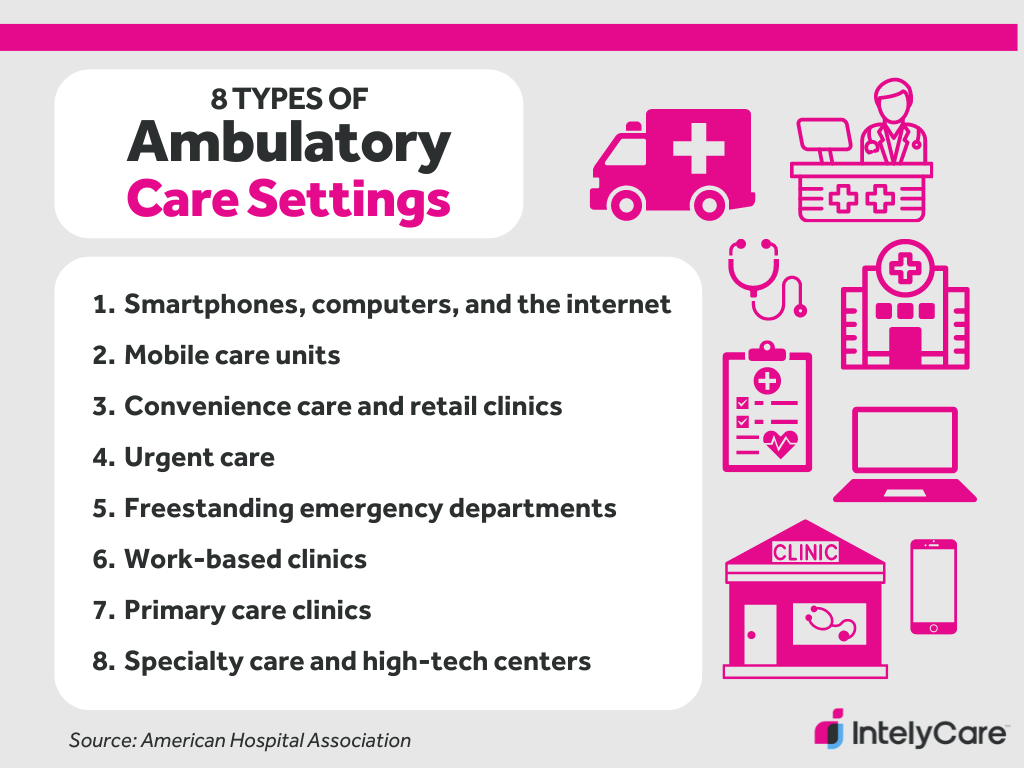What Is Ambulatory Care Nursing?

Ambulatory medicine is the bridge between home and the hospital. You might have heard the term before, but what is ambulatory care? These distinct practice settings help relieve the burden on inpatient facilities, while giving patients the expertise of an interprofessional team. They’re essential hubs for disease prevention, treatment, education, and population health management.
The term “ambulatory” is a descriptive word that means that someone is able to walk. This is a bit of a misnomer, since patients can come to ambulatory care in wheelchairs or with assistance. But this specialty field supports a patient’s ability to live at home and get the healthcare they need while remaining mobile.
If you’re a nurse interested in learning more about outpatient career options, ambulatory care might be a great specialty for you. Ambulatory care nurses learn essential skills of triage, assessment, interprofessional collaboration, and more.
But what is ambulatory care nursing, exactly? Before we dig into this question, we need to give more context for why ambulatory care is essential to modern medicine.
What Does Ambulatory Care Mean and Why Is Ambulatory Care Important?
Ambulatory care is an umbrella term for outpatient medicine, meaning that patients come in for care and leave by the end of the day. This model emphasizes timely, efficient, and accessible healthcare.
What is an example of ambulatory care? Ambulatory care services include routine checkups, minor surgeries, diagnostic procedures, and ongoing management of chronic conditions. If you’re been to a primary care appointment, gone to see a specialist, or gotten your flu shot at a pharmacy, you’ve experienced ambulatory care.
These centers play a vital role in supporting community health and ensuring individuals receive appropriate medical attention for chronic and acute illnesses. Patients can maintain their routines and ADLs (activities of daily living) and live a normal life while getting medical care.
Ambulatory centers are critical for disease prevention, education, and ongoing health maintenance. These outpatient settings are where nearly 90% of patient care is given.

What Is an Ambulatory Care Center?
An ambulatory care center is anywhere that patients access care on an outpatient basis. There’s no one model for ambulatory care. Technology has helped expand models of access, and there are now eight types of ambulatory care settings laid out by the American Hospital Authority:
- Smartphones, computers, and the internet: Patients access providers through medical websites and remote portals.
- Mobile care: Converted buses are modes of access for patients who otherwise might not be able to access care. These come equipped with technologies and patient monitoring equipment.
- Convenience care and retail clinics: These are typically inside retail stores, where patients can get limited treatment from mid-level providers.
- Urgent care: These clinics offer small lab assessments, sutures, and general radiography, and see patients on a scheduled or walk-in basis.
- Freestanding emergency departments: These fall between urgent care and emergency departments. They’re typically open 24/7 and don’t have the diagnostic capabilities of EDs.
- Work-based clinics: Occupational health and work campus health centers are increasingly common for manufacturing and tech companies. These help keep employees healthy while maintaining productivity.
- Primary care clinics: The team-clinic model helps patients access a group of specialists in one visit. Some of these clinics have diagnostic capabilities and are linked to larger health systems.
- Specialty care and high-tech centers: These centers help treat patients who need specific care on a weekly or monthly basis, offering treatments such as:
-
-
- Diabetes management
- Dialysis
- Endoscopy
- Infusion
- Interventional radiology
-
What Is an Ambulatory Care Unit?
Ambulatory care units are typically specialized outpatient facilities that offer treatments such as intravenous infusions, dialysis, chemotherapy, or surgical procedures. Patients come in, get assessed, see their providers for treatments, and go home afterwards. This is just one model of ambulatory care.
What Is Ambulatory Care vs. Outpatient Care?
While the terms sound different, they represent the same model of patient care. Any time a patient accesses medical treatment without being admitted to the hospital, they’re experiencing the benefits of ambulatory and outpatient care.
What Is Ambulatory Care vs. Primary Care?
Primary care is a model of ambulatory care. In primary care clinics, healthcare teams build partnerships with patients to help them understand, maintain, and monitor their health. These clinics are essential centers for health promotion, illness treatment, and prevention.
What Is Ambulatory Care Nursing?
Ambulatory care nurses are essential team members in outpatient care centers. The American Association of Ambulatory Care Nursing (AAACN) has created a comprehensive definition of ambulatory care nursing. Here’s a summary:
Ambulatory care is a specialized field combining collaborative and independent practice. Ambulatory care nurses care for individuals, groups, and populations seeking health assistance or care for health-related issues in outpatient settings. This care ranges from promoting wellness and managing acute illnesses, to supporting patients with chronic diseases and disabilities. Ambulatory care nurses use evidence-based practice to guide care and improve patient outcomes by adhering to professional standards.
Because ambulatory care is a bit of a catch-all term for outpatient medical settings, the skills and experience of ambulatory nursing are very different across care centers. Patients in outpatient centers come in with a range of needs and illnesses, and nurses in these settings still need specialized skills to give patients the best outcomes.
Ambulatory Care Nursing Salary
The average ambulatory care salary for RNs is $102,640 per year. This amount can vary depending on experience, location, specialty, and the nurse’s credentials. For example, take a look at current urgent care RN jobs to see what you might earn.
Ambulatory Care Nursing Education: 4 Steps
If you’re interested in being an ambulatory care nurse, there are four steps you’ll need to take to start practicing:
1. Go to Nursing School
An associate or bachelor’s degree in nursing is the first step to becoming a registered nurse. In nursing school, you’ll learn essential skills like assessment, documentation, and the nursing process.
2. Pass the NCLEX-RN
The National Certification and Licensure Exam for Nurses (NCLEX-RN) assesses your readiness to practice. Once you’ve passed, you’ll be licensed to practice in your state. Learn more about the new NCLEX exam.
3. Gain Ambulatory Care Experience
Once you have your license, you’ll be able to enter an ambulatory care setting as a new graduate nurse. Some new graduates prefer to get inpatient experience first to build their skills and critical thinking skills. But if ambulatory care is where you want to be, you can jump right in.
4. Become a Certified Ambulatory Care Nurse
The Ambulatory Care Nursing Certification (ACNC) is the national certification for ambulatory care nurses. In order to sit for the exam, you’ll need to meet specific requirements:
-
-
- Have a current RN license
- Have 2 years of full-time nursing practice
- Have a minimum of 2,000 hours of practice in ambulatory care in the past 3 years
- Have completed 30 hours of continuing competency in ambulatory care nursing in the past 3 years
-
Looking for Ambulatory Care Opportunities?
Hopefully you can now answer the question — What is ambulatory care nursing? If you’re seeking your next nursing opportunity, IntelyCare has outpatient nursing roles across the nation. Get tailored job listings sent right to your inbox.
